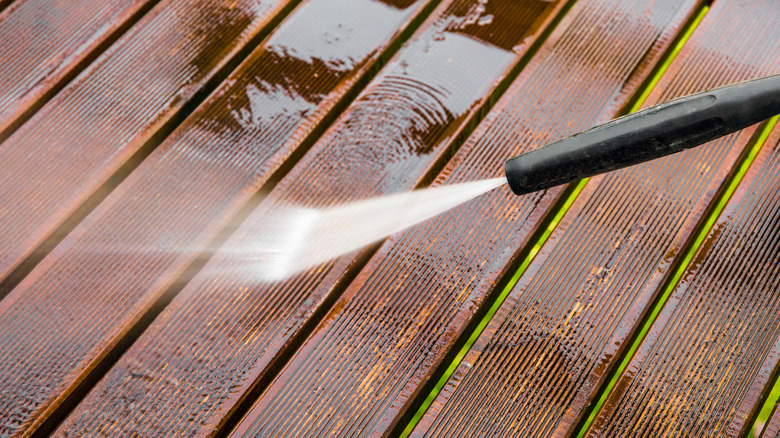What To Consider Before Painting Your Porch Floor
There's nothing more relaxing than sitting out on your front porch. Whether you're winding down your evening with family or having a morning coffee, your outdoor space can be the best place to be. Part of that relaxation comes from creating a front porch oasis that feels like an extension of your home. An easy way to transform this space is by painting the floor. Though it's an easy task that most homeowners can take on their own, there are a few things you should consider first.
Putting as much thought into the prep work as you do the design of the porch can directly impact your results. Properly prepping the surface helps ensure that it'll stand up to the elements and last for years to come. "Prep work is huge," Nashville designer Chelsea Robinson tells Southern Living. "I think there's really more work involved in prepping than there is the actual painting."
Of course, you also want to consider the proper materials and the color and design before you get started. Spending more time in this planning phase can give you a long-lasting and impressive outcome. And this will allow you to enjoy your porch and keep it looking nice season after season.
Prepping your porch is essential
Without the proper prep, the quality of the final product and the level of adhesion won't be its best. Paint may become vulnerable or peel after being exposed to the weather and elements. Plus, surface preparation is the key to a clean and professional-looking finished product.
First, clear the porch of all furniture, area rugs, decorative objects, or anything else that may get in the way. Thoroughly clean the surface by sweeping up any dirt or debris with a push broom. Then, wash the surface using a pressure washer. If there are previous coats of paint, be sure to remove any remnants to create a smooth surface.
Next, you want to consider the material to help ensure you're choosing the right paint. If your floor is wood, you can use latex-based or oil-based exterior paint as well as a deck stain. With concrete porches, however, you should only use latex-based paints or epoxy. It's also a good idea to use a primer for both wood and concrete porches, as that will help the paint to stick to the surface. As for applying the paint, you can use either a roller or a sprayer.
Have fun with color and pattern
Once the prep work is done and the primer is dry, you can begin to apply the actual paint. But before that, you have to decide on exactly what shade of paint. One place to start is with the details of your home's exterior. Match or coordinate your porch color with the colors of your siding, front door, or window shutters to ensure a cohesive exterior. Another place to start is with the landscape and surroundings. Homes by water may want to consider a shade of blue or a crisp white. However, more wooded areas can go for a moodier green or dark red to match the world around them.
Neutrals like white will pair well regardless of your location, home style, or other surrounding details. Creamy whites, like Natural White from Behr, look luxurious and add a bit of brightness to the exterior. Greige and silver gray add a hint of sophistication and timelessness by adding a little color to your typical neutral. Dark, bold shades like navy make a statement, drawing attention to this exterior detail.
You also don't have to feel limited in choosing one solid color. Add visual interest by painting a pattern on your porch and making it a focal point. Consider stripes, chevron, herringbone, or diamond patterns across the porch floor. Using large-scale patterns can also make the area appear larger and instantly boost your curb appeal's character.


